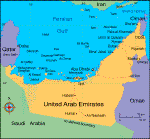|
|
|
Area 83,000 sq km includes approx. 200 islands |
|
Religion Islam |
|
Currency Dirhams and fils 100fils = 1 Dh 1 US$ = 3.67 Dh |
|
Time Four hour ahead of GMT |
|
Emirates Made up of seven emirates Sharjah Ajman Umm Al Quwain Al Khaimah Fujairah |
GEOGRAPHY OF UAE UAE lies between 22°50' and
The UAE stretches for more than 650 kilometers along the southern shore of the
Persian Gulf. Most of the coast consists of salt pans that extend far inland. The largest
natural harbor is at Dubai, although other ports have been dredged at Abu Dhabi,
Sharjah, and elsewhere. Numerous islands are found in the gulf. The smaller islands,
as well as many coral reefs and shifting sandbars, are a menace to navigation. Strong
tides and occasional windstorms further complicate ship movements near the shore. |
|
HISTORY OF UAE The gestation period of this country was not altogether a straightforward one. It took nurturing and
plenty of nourishment
before the birth of a healthy new state could be contemplated - let alone guaranteed.
The idea of the various sheikhdoms in the Gulf co-operating for their mutual security was first seriously and realistically talked
of in 1967. Their great wealth, small size and strategic location made them especially vulnerable to threats. But the idea,
reportedly initiated by His Highness Sheikh Zayed Bin Sultan Al Nayhan, to provide greater self-protection gained momentum
only when the British announced their intention to withdraw from the Gulf. The Trucial States are unique in history in that they
expressed a reluctance at the prospect of Britain leaving the region. Britain had provided
protection and with the discovery of
oil this was even more of an everyday need.
Indeed, the decision of the British to withdraw was the result not of a clamour for independence along the Trucial Coast but of
domestic policy concerns at home. The Labour government responded to the growing calls among its rank and file members
for a reduction in defence spending by announcing that it would pull out of almost all its military bases east of Suez. On 16th
January 1968, the British Prime Minister, Harold Wilson, told the House of Commons that Britain's presence in this part of the
world would end by the closing days of 1971.
From the end of the 1960's, right up until the formation of the United Arab Emirates, there was the possibility (indeed at times
very much a probability) that the two would become a part of the union.
By the end of the month, they had also invited the other Trucial states and Qatar and Bahrain to become part of a larger
federation.
In the spring of 1971, the British Foreign Minister, Sir Alec Douglas Home, announced the idea of a Friendship Treaty
between Britain and the 'Arab Emirates of the Gulf', which was to replace the existing treaties between the states.
Things moved quickly, with a communiqué announcing the planned formation of the United Arab Emirates in July 1971, and
meetings with legal advisors were held and discussions between the rulers took place.
Ras Al Khaimah did not join the union until just over two months after its birth, the hesitation stemming from its representation
and the complication of a potential oil find off its coast around that time.
When the proclamation of a new state was made on 2nd December 1971, the great hope was
expressed "that this federation
will form the nucleus of a complete federation which will include the remaining members of the brotherly family of emirates". Ras Al Khaimah officially joined the UAE on 1st February 1972. The membership of Al Imarat Al Arabiyya Al Muttahida (UAE) was complete. |
